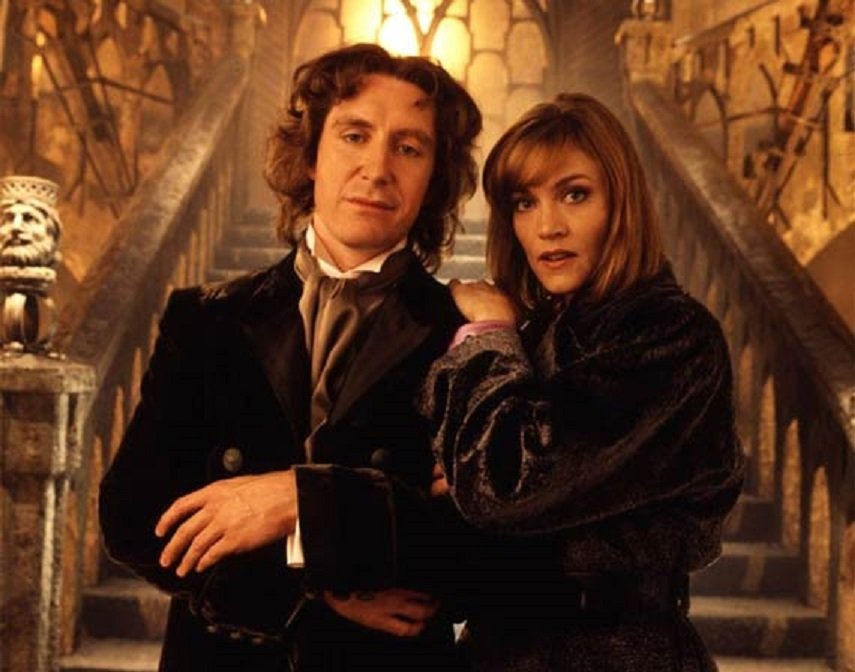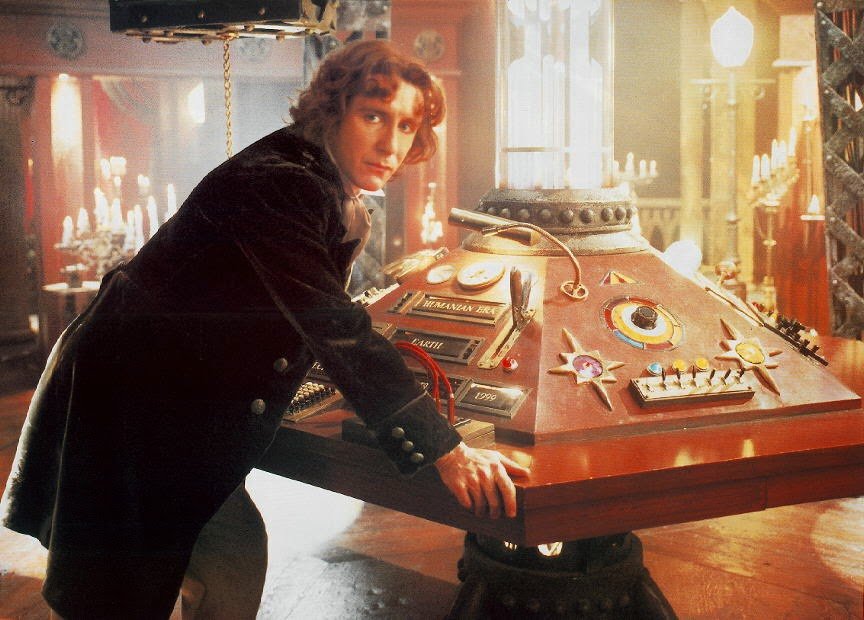With the success of the 2005- present series of Doctor Who, we are hearing more and more backlash from many fans about the canonical nature of 1996’s The TV Movie (TVM hereafter) starring Paul McGann. Most complain that it was “Americanized,” that the plot was jumbled, or that it messed too much if the past history of the show.
But was the TVM so different? Does it deserve its place in the history of the show?
Let’s take a look at the Eighth Doctor’s only full TV outing and see just how different it really was.
One thing that most fans agree on is that Paul McGann made a fantastic Doctor. Even his outfit was in keeping with the show’s past. It was very Edwardian and helped him to stand out in a crowd. He even wore a wig (which he hated), much like William Hartnell.
To be honest, getting the Doctor right seems like pretty much half the job there. After that, all you need is a good companion, the TARDIS, an alien threat (or major historical event), and a good story.
Let’s look at the new companion, Dr. Grace Holloway, played by Daphne Ashbrook. Grace is a medical doctor with a career and a life already in motion for herself before she meets the Doctor and gets caught up in his hectic world of saving the universe, or as is more often the case, the Earth. From her first scene entering the TARDIS, we can see that she has a good understanding of scientific theories as well as her medical skills. (True, this could be the Master’s influence over her, but nonetheless it’s there.) But is she right? Is this too different for Doctor Who?

It would seem that Grace set the standard for one-off companions. Until the new series invited Catherine Tate back to the show as a full on companion, she was, by all intents and purposes, considered a companion. Who knows if she would have been given that title had the precedent not been laid out before by Daphne Ashbrook’s character?
As I said before, Grace is an intelligent woman, not to mention a beautiful one, and recalling the previous 26 years of past companions, it’s easy to see that Dr. Holloway fits in with the history of the show. You need only to look as far back as the Jon Pertwee era where we have the pretty and very brilliant Dr. Elizabeth Shaw (Caroline John) to see that Grace is in good company. Fast forwarding to 2007 – can you believe it’s been 10 years?! – we can see Dr. Shaw’s, but more so, Dr. Holloway’s influence in the character of medical student, Martha Jones (Freema Agyeman).
Not so different so far. Let’s try another…
The TARDIS. From the exterior, it seems to be the same machine as ever: a big, blue Police Box. The interior, however, is a subject of much fan debate.
For one thing, it is still much bigger on the inside than the outside. Chalk one up for the TVM. It still has a central console and center column that rises and falls when in flight. That’s 2 for the TVM. The console is made of wood, however. Could we have a difference here? A deviation from the original series? No, I don’t think so.
Looking back as far as the Tom Baker era, we can clearly see that, for a few seasons at least, the console room and the console itself were both made out of wood. We also saw the Doctor give the console a complete overhaul in the Peter Davison era, and Sarah Jane mentioned a “redecoration” of the console room in School Reunion. So it’s natural to assume that the Doctor had redecorated again some time before the TVM and was forced, or preferred to use 19th Century components in his ship.
The TVM also seems to have influenced the Russell T. Davies era once again with its console design. This can clearly be seen in the floor to ceiling central column – continued in subsequent TARDISes – as well as the coral support structures that mimic the steal framework surrounding the TVM console.

Another complaint heard from many fans is the stonework and leaves that were in the room with the Eye of Harmony. Which is odd when you think about it, because in Tom Baker’s last story, Logopolis, we see that the cloister room had both stonework and vines in abundance. In fact, going further back to The Invasion of Time, we are shown that the TARDIS interior can change its shape just like the exterior. In that story, we see the Castellan press a button on a stone statue that disappears along with the rest of its surroundings in that section of the ship. This would prove that the Doctor’s ship is capable of making solid structures out of holograms, or perhaps nano technology.
The New Series is keen to point out that the TARDIS is a living machine (a concept that has been mentioned in the past as well) and proves this with its coral design growing all over the place. That and the Doctor’s comment that TARDISes are grown (in The Impossible Planet) show very clearly that vines and leave should seem right at home in this living structure.
“But,” I hear you stammer, “you mentioned the Eye of Harmony but didn’t explain it; did you think we would let you get away with that?” No, not really. Here we go:
Yes, the TVM placed the Eye of Harmony inside the TARDIS, where previously we had seen it only on Gallifrey itself. This doesn’t mean that it is a break from continuity though. Until The Deadly Assassin, we’d never heard of the Eye, so why should we assume that it was never in the TARDIS before now? After all, we never knew the TARDIS had a Zero Room before the Fifth Doctor needed it in Castrovalva. We also never heard the word “regeneration” until the Third Doctor did just that at the end of his era. We also found out about ‘the Chameleon Arch’ in Human Nature (2007), which seems to have been a permanent feature in all TARDISes, yet it was new to us, and the Architectural Reconfiguration System, probably the most notable addition to the mythos from Journey to the Centre of the TARDIS (2013). I expect there is a lot we don’t know about this ship.
Next we have the alien threat, the Master (Eric Roberts). Executed by the Daleks and yet still clinging to life with every ounce of evil that he is.

Now we get to the good stuff.
Daleks holding a trial ending in the execution of the Master and not their mortal enemy, the Doctor, who came to collect his remains from them? Not so odd when you think about it. Going way back now to the Patrick Troughton era, we know that the Doctor gave a group of Daleks emotions and personalities when he inserted the “human factor.” It would make sense that these Daleks are still out there, growing in numbers, and trying to better the universe. Since the Doctor gave them new life, it also makes sense that they would not try to exterminate him when he shows up on their doorstep to retrieve the Master’s urn.
With that in mind, it would also be believable that, with these newfound emotions, they would gain a sense of society and hold fair trials for their criminals rather than just exterminating them on sight.
Another possibility that could explain this trial, if a second one was needed, is the revelation of “The Cult of Skaro,” the elite group of Daleks crated by the Emperor to think outside the box. This trial of the Time Lord could have been an exercise in understanding for the Cult. Just one of their experiments. Perhaps they even brokered a truce with the Time Lords during this period as part of those experiments.
I said in the beginning of this article that some complain about the Americanization of this story and when I ask what they mean by this, I am usually given the motorcycle chase scene as an example. When this happens, I refer them back to the James Bond era– er, Pertwee era, to see that the motorcycle scene was not so far removed from its past.
The New series seems to understand the need for a good chase scene as well when they had the Doctor and Rose on a moped in The Idiots Lantern (2006). Which I might add was a totally British production.
The story itself seems like the last stop here.
It’s said to be potpourri of ideas over the 9 years the show was off air, but more so it is considered to be a bit of a rehash of a Tom Baker story, The Deadly Assassin. But is this true? It’s certainly not a word-for-word copy of the script. The main similarity is the Master’s use the Eye of Harmony to gain more lives.
In The Deadly Assassin, he tried to use the power of the eye itself to give him new life. In the TVM, he uses it to try to steal the Doctor’s life. Different enough. If you try to make a house out of wood and fail on the first try, you don’t say “That’s it, I’m using brick!” No! You “try, try, try again.” A good idea is a good idea, and when you are clinging to life with only one chance in sight, you take it.
This story also brought us the Doctor’s first on-screen kiss, but because it is a battered old subject, I’ll leave you with this thought: Susan is the Doctor’s Granddaughter. She had to come from somewhere, and although kissing doesn’t make babies, it is the first step in the process that gets you there. Not convinced? Remember that Paul McGann’s Doctor kissed his new friend during a fit of happiness upon remembering who he was – this is no different than Tom Baker’s or Patrick Troughton’s boisterous hugs with their companions during bouts of happiness. Sometimes a kiss is just a kiss.
Looking back on this, it’s nice to see that while there is change, it was still very traditional. In fact, throughout the 26 years of the original series, change was a constant. The TVM was no different and now the New Series is proud to continue the trend. In the end, the TVM is just as canonical as the story that started it all way back in 1963. And if you’re still arguing against this, I recommend The Night of the Doctor (2013), and try to deny it then.
(Adapted from an article originally published on Kasterborous in November 2007.)
Privacy Overview
This website uses cookies so that we can provide you with the best user experience possible. Cookie information is stored in your browser and performs functions such as recognising you when you return to our website and helping our team to understand which sections of the website you find most interesting and useful.
Strictly Necessary Cookies
Strictly Necessary Cookie should be enabled at all times so that we can save your preferences for cookie settings.
If you disable this cookie, we will not be able to save your preferences. This means that every time you visit this website you will need to enable or disable cookies again.
